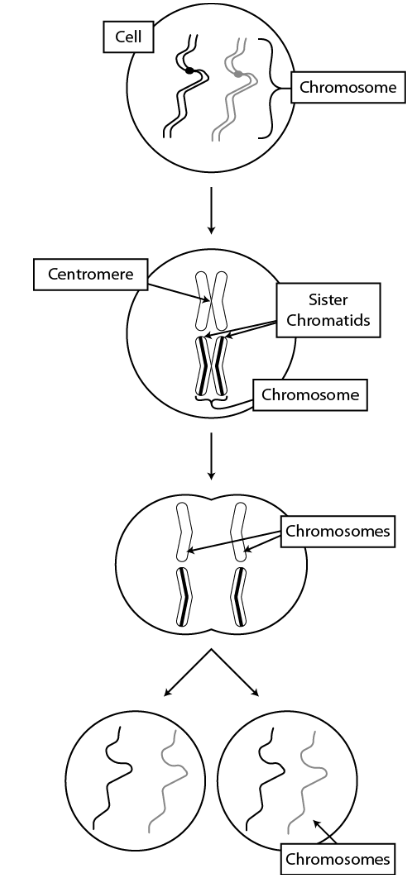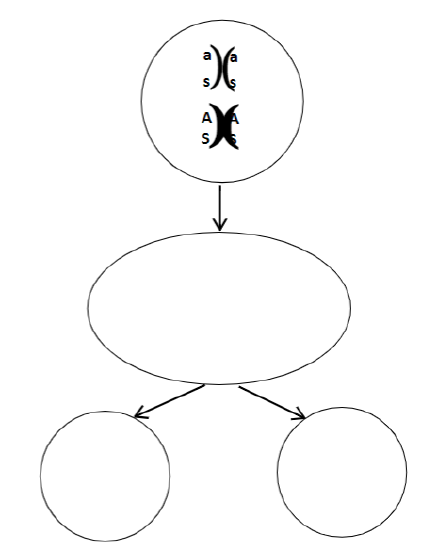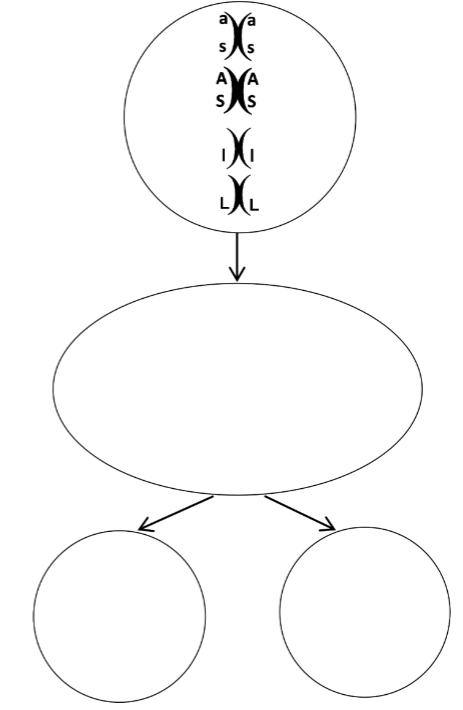6.1: Mitosis Protocol
- Page ID
- 25118
Genes and Chromosomes
You probably already know that genes can influence a person's characteristics. For example, some people have genes that result in sickle cell anemia or albinism (very pale skin and hair). In this section, you will learn how genes in chromosomes influence our characteristics.
Each cell in your body contains chromosomes. Each chromosome contains a long molecule of DNA. Each DNA molecule contains many genes. A gene is a segment of a DNA molecule that gives the instructions for making a protein.
Different versions of the same gene are called alleles. Different alleles give the instructions for making different versions of a protein. This table shows the alleles of two human genes.

1. In the table, circle each symbol that represents part of a DNA molecule. Underline each word that is the name of a protein.
|
Allele |
⇒ |
Protein |
|
A |
⇒ |
Normal enzyme for producing melanin, a pigment molecule that gives color to our skin and hair |
|
a |
⇒ |
Defective enzyme that cannot make melanin |
|
S |
⇒ |
Normal Hemoglobin |
|
s |
⇒ |
Sickle Cell Hemoglobin |
Chromosomes come in pairs of homologous chromosomes. In each pair of homologous chromosomes, both chromosomes have the same genes at the same locations. A gene may have different alleles on the two homologous chromosomes (e.g. Aa) or a gene may have the same alleles (e.g. SS).

The table below shows how different genotypes (i.e. different combinations of alleles) result in the production of different proteins which in turn result in different phenotypes (i.e. different observable characteristics).
|
Genotype |
⇒ |
Protein |
⇒ |
Phenotype (characteristics) |
|
AA or Aa |
⇒ |
Enough normal enzyme to make melanin in skin and hair |
⇒ |
Normal skin and hair color |
|
aa |
⇒ |
Defective enzyme for melanin production |
⇒ |
Very pale skin and hair color; albino |
|
SS or Ss |
⇒ |
Enough normal hemoglobin to prevent sickle cell anemia |
⇒ |
Normal blood; no sickle cell anemia |
| ss |
⇒ |
Sickle cell hemoglobin, which can cause red blood cells to become sickle-shaped. |
⇒ |
Sickle-shaped red blood cells can block blood flow in the smallest blood vessels, causing pain, etc.; sickle cell anemia |
2. Suppose that Jim has the alleles in the pair of homologous chromosomes shown in the above circle.
Is Jim's genotype ___aaSs ___AaSs ___AaSS?
Is Jim an albino? ___yes ___ no
Does Jim have ___ sickle cell anemia ___ normal blood?
3. Explain why a person with the aa genotype has very pale skin and hair color. Include the words enzyme and melanin in your explanation.
4. Fill in the blanks of the following sentences.
A chromosome contains one long ______ molecule. Each gene in this ______ molecule gives the instructions for making a ____________________. Both chromosomes in a pair of ______________________ chromosomes have the same genes, but the genes in these two _____________________ chromosomes may have different ____________.
Many of the genes on each chromosome give the instructions for making a large number of proteins that are needed for normal cell structure and function. Therefore, each cell needs to have a complete set of chromosomes with all of these genes.
Cell Division — How New Cells Are Made
Each of us began as a single cell, so one important question is:
How did that single cell develop into a body with more than a trillion cells?
The production of such a large number of body cells is accomplished by cell division repeated many many times. First, one cell divides to form two cells; then both of these cells divide to produce a total of four cells; then these four cells divide to produce eight cells, etc. Thus, repeated cell division is needed for growth.
5. Even in an adult, some cells continue to divide. Why is cell division useful even in an adult who is no longer growing? (Hint: Think about what happens when you have an injury that scrapes off some of your skin.) Almost all the cells in our bodies are produced by a type of cell division called mitosis. In mitosis, one cell divides to produce two daughter cells, each with a complete set of chromosomes. (It may seem odd, but the cells produced by cell division are called daughter cells, even in boys and men.)
6. Before mitosis begins, a cell makes a copy of all the DNA in each chromosome. What would go wrong if a cell did not make a second copy of all of its DNA before the cell divided into two daughter cells?
Mitosis — How Each Daughter Cell Gets a Complete Set of Chromosomes
This figure shows mitosis for a cell that has a single pair of homologous chromosomes. To indicate that these two homologous chromosomes have different alleles for many of their genes, one chromosome is shown as dark or striped.
Preparation for Mitosis
To prepare for mitosis, the cell makes a copy of the long DNA molecule in each chromosome; this is called DNA replication. DNA replication results in two identical copies of the DNA with the same alleles for each of the genes.
Beginning of Mitosis
Each copy of the long DNA molecule is wound tightly into a compact chromatid. The two chromatids in each chromosome are called sister chromatids; they are attached at a centromere. The chromosomes are lined up in the center of the cell.
Mitosis Continues
Next, the two sister chromatids of each chromosome are separated. After they separate, each chromatid is an independent chromosome.
Cytokinesis
The cell pinches together in the middle and separates into two daughter cells, each with a complete set of chromosomes. Thus, each daughter cell has a complete copy of all the genes in the original cell. The DNA in each chromosome unwinds into a long thin thread.
7. Explain why the chromosomes in the second drawing have sister chromatids, but the chromosomes in the third drawing do not. What happened to the sister chromatids?
8. This fill-in-the-blank question reviews the information from the previous page and provides some additional information about six steps that are needed for mitosis to occur.
A. In preparation for mitosis, DNA is copied; this is called DNA ______________________.
B. Each copy of the DNA is wound tightly (condensed). Now each chromosome has two compact sister ___________________. These compact chromosomes are easier to move than the long thin chromosomes in a cell which is not undergoing cell division. Spindle fibers which will move the chromosomes begin to form.
C. Spindle fibers attach to the chromosomes and line up the chromosomes in the middle of the cell.
D. Spindle fibers pull the sister ___________________ apart to form separate chromosomes which are moved toward opposite ends of the cell.
E. In a process called __________________________, the cell pinches in half, with one complete set of chromosomes in each half.
F. Two identical _________________ cells are formed. Each _________________ cell has received a complete set of chromosomes. The DNA in each chromosome unwinds into a long thin thread so that genes can become active and give the instructions for making proteins.
9. For each of the figures below, give the letter of the corresponding step described above. Draw arrows to indicate the sequence of events during cell division. (The figures show mitosis for a cell that has only 4 chromosomes (2 pairs of homologous chromosomes). The basic process is the same in a human cell which has 46 chromosomes.)

10. Circle each pair of homologous chromosomes in step C. Use an asterisk (*) to mark the arrow you drew which shows when sister chromatids separate to form individual chromosomes.
Modeling Mitosis with One Pair of Homologous Chromosomes
- Find a pair of model homologous chromosomes, one with the a and s alleles and the other with the A and S alleles. Both model chromosomes should be the same color, but one model chromosome will have a stripe on both chromatids to indicate that, although these two homologous chromosomes have the same genes, they have different alleles for many of their genes. The shape of the model chromosomes indicates that the DNA has already been copied and wound tightly into sister chromatids.
- Sit across from your partner and use your arms to represent the spindle fibers that move the chromosomes. Begin mitosis by lining up the model chromosomes in the middle of the cell (see figure below). Use a string to indicate the cell membrane that surrounds the cell that contains these chromosomes.
- Demonstrate how the sister chromatids of each chromosome are separated into two separate chromosomes which go to opposite ends of the cell.
- Now the cell is ready for cytokinesis which will produce two daughter cells, each with a complete set of chromosomes. Rearrange the string to demonstrate cytokinesis and then cut the string to form the cell membranes surrounding each daughter cell.
- Model mitosis again and answer question 11. (To do this, you will first need to put the sister chromatids of your model chromosomes back together. This does not correspond to any biological process – it is just necessary in order to continue your modeling activity.)
11. Record the results of your modeling in this figure. Draw and label the chromosomes in the oval and in the daughter cells.
The original cell at the beginning of mitosis (after DNA has been replicated and condensed into sister chromatids).
Sister chromatids have separated to form separate chromosomes.
Daughter Cells
12. The original cell had the genetic makeup AaSs. What is the genetic makeup of the daughter cells?
Are there any differences in genetic makeup between the original cell and the daughter cells produced by mitosis?
Multiple Pairs of Homologous Chromosomes
Each human cell has 23 pairs of homologous chromosomes. Each of these pairs of homologous chromosomes has its own unique set of genes. For example, human chromosome 11 has the genes that can result in albinism and sickle cell anemia (as well as more than 1000 additional genes). Human chromosome 12 has different genes, including a gene that can result in alcohol sensitivity. This table shows the effects of the L and l alleles of this gene.
|
Genotype |
⇒ |
Protein |
⇒ |
Phenotype (characteristics) |
|
LL or Ll |
⇒ |
Defective enzyme that cannot dispose of harmful molecules produced by the metabolism of alcohol |
⇒ |
Skin flush and discomfort after drinking alcohol |
| ll |
⇒ |
Normal enzyme that disposes of harmful molecules produced by alcohol metabolism |
⇒ |
No flush or discomfort after drinking alcohol |
Modeling Mitosis with Two Pairs of Homologous Chromosomes
- Find a second pair of model homologous chromosomes, one with the L allele and the other with the l allele. Model mitosis for a cell with two pairs of homologous chromosomes.
13. Record the results of your modeling in this figure.
The original cell at the beginning of mitosis (after DNA has been replicated and condensed into sister ).
Sister chromatids have separated to form separate chromosomes.
Daughter Cells
14. The original cell had the genetic makeup AaSsLl. What is the genetic makeup of the daughter cells?
Are there any differences in genetic makeup between the original cell and the daughter cells produced by mitosis?
Follow-Up Questions
15. Suppose that your partner has put the model chromosomes back together as shown in the diagram. What is wrong? Explain why, in a real cell, sister chromatids could not have different alleles.
What is wrong with these model chromosomes?
16. Each of the cells in your skin, brain, and other parts of your body has a complete set of chromosomes with the same genes and the same alleles that were present in the single-cell that developed into your body. Explain how these billions of genetically identical cells were produced. Include the following terms in your explanation: chromosome, cytokinesis, daughter cell, DNA replication, genes, mitosis, sister chromatids, and spindle fibers.
Some animals and plants use a combination of mitosis and splitting off to reproduce. For example, a hydra can reproduce by budding. The bud is formed by many many repetitions of mitosis, and then the bud breaks off to form a daughter hydra. (A hydra is an animal that lives in the water and uses its tentacles to catch food.)

17. Will there be any genetic differences between the mother hydra and the daughter hydra? Explain your reasoning.

